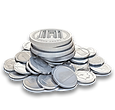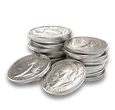How to Avoid Overpaying for Collectible Coins: A Comprehensive Guide for Smart Buyers
- GoldsilverJapan

- Sep 20
- 5 min read
Collecting coins can be a deeply rewarding experience — intellectually, financially, and emotionally. But anyone who has been in the world of numismatics knows that one of the biggest pitfalls for collectors, especially beginners, is overpaying for collectible coins.
Whether you're browsing online marketplaces, shopping at coin shows, or working with dealers, it's easy to fall into the trap of paying more than a coin is truly worth — sometimes significantly more. This article explores how to avoid overpaying for collectible coins by offering insights into pricing, grading, authentication, dealer practices, market cycles, and more.
🔍 Why Do People Overpay for Coins?
Understanding the psychology and market dynamics behind overpaying is key. Here are some common reasons why collectors spend more than necessary:
Emotional Attachment: Falling in love with a coin, especially a rare or visually appealing one, can cause buyers to act irrationally.
Lack of Knowledge: Many buyers simply don't understand grading standards, rarity scales, or fair market value.
Scarcity Tactics: Dealers or sellers may pressure buyers by suggesting that the coin won’t be available later.
Marketing Hype: Social media and advertisements can create buzz around certain coins, driving up perceived value.
💡 Step 1: Learn Coin Grading Standards
The value of collectible coins is heavily influenced by their grade, which reflects the coin’s condition. Understanding basic grading terminology is essential to making smart purchases.
ANA Grading Scale (U.S. Coins)
PO to G (Poor to Good): Heavily worn coins with little detail left.
VG to F (Very Good to Fine): Moderate wear but major details are visible.
VF to XF (Very Fine to Extremely Fine): Some high-point wear, but overall sharp detail.
AU (About Uncirculated): Nearly mint state, with light wear.
MS (Mint State): Uncirculated coins graded MS60–MS70.
Proof (PR or PF): Specially struck coins for collectors.
Always compare the seller’s stated grade to third-party certified grades (PCGS, NGC, ANACS) whenever possible. Don't accept a seller's label without evidence.
📊 Step 2: Check Market Prices and Auction Results
You should never buy a coin without checking:
Current market value
Past auction prices
Comparable sales on platforms like eBay, Heritage Auctions, and GC
Tools to Use:
PCGS CoinFacts: For U.S. coins, includes population reports and price trends.
NGC Price Guide
Greysheet (CDN): Dealer-level pricing guide.
eBay Sold Listings: Look for coins that actually sold, not just listings.
GoldSilverJapan Coinpedia AI Coin Assistant | GoldSilverJapan
For example, if a 1921 Peace Dollar graded XF45 sells consistently for $90–$110, a dealer asking $175 is overcharging — unless there's something unique about the coin (toning, error, etc.).
🛡 Step 3: Buy Certified Coins from Trusted Sources
Buying graded coins from third-party graders like PCGS or NGC dramatically reduces the risk of overpaying or buying counterfeits. Certified coins come sealed in tamper-proof holders and are graded by professionals using industry-standard criteria.
Trustworthy Certification Services:
PCGS (Professional Coin Grading Service)
NGC (Numismatic Guaranty Corporation)
ANACS (American Numismatic Association Certification Service)
ICG (Independent Coin Graders)
Avoid buying raw (ungraded) coins unless you're experienced or dealing with a very trusted seller. Many raw coins are misrepresented or overgraded.
🛒 Step 4: Compare Prices Across Dealers and Platforms
Don't settle for the first price you see. Coin prices can vary widely between platforms, dealers, and even regions.
Compare:
Online marketplaces (eBay, MA-Shops, VCoins)
Auction houses (Heritage, Stack’s Bowers, GreatCollections)
Local dealers and coin shops
Online dealers (Apmex, GoldSilverJapan, JM Bullion, etc.)
Each seller includes different premiums based on overhead, market access, or target customer. Know what others are charging for the same item.
🧾 Step 5: Understand Premiums and Overhead
The price you pay includes more than just the coin's intrinsic value. Learn what goes into a seller’s pricing.
Typical Markups:
Bullion coins: 2–15% over spot
Semi-numismatics: 10–50% over melt value
Rare coins: Varies, sometimes hundreds of percent
For example, the 2020 Australian Swan 1 oz Silver coin was initially sold with a 70–100% premium due to marketing hype. Many collectors bought it expecting appreciation — but it’s now often traded near bullion value.
❌ Step 6: Avoid Common Red Flags
Look out for these warning signs that you might be overpaying:
❗ Vague grading language (e.g., “gem BU”)
❗ “Too good to be true” prices (counterfeit alert!)
❗ No return policy
❗ Pressure tactics (“Only one left!”)
❗ Inflated shipping or handling fees
❗ Coins with a high markup but no certification
Be especially cautious with coins sold via social media, classified ads, or unverified sellers on marketplaces.
🧠 Step 7: Know the Coin Type and Market Behavior
Different types of coins behave differently in the market. Understanding what you're buying can help prevent overpaying.
Types of Coins:
Type | Description | Risk of Overpaying |
Bullion | Based on metal value | Low |
Semi-Numismatic | Bullion with collectibility (e.g., Queen’s Beasts) | Medium |
Numismatic | Rare historical coins | High |
Modern Commemorative | Mint-issued for collectors | High |
Semi-numismatic coins like the British Queen's Beasts or Canadian Wildlife Series may carry large premiums early on, but tend to lose that premium once collector hype dies down. If you’re buying them, do it for fun — not for guaranteed profit.
🤝 Step 8: Work With Reputable Dealers
Find a dealer with a strong track record, fair return policies, and solid reviews.
Checklist for a Good Dealer:
💬 Transparent about pricing and premiums
🛡 Offers third-party certified coins
🔄 Provides return/refund policy
📈 References recent market data
💳 Multiple payment methods
🇯🇵 Local options in Japan: GoldSilverJapan offers a variety of bullion and certified coins at competitive pricing, plus Japanese-language support.
🔎 Step 9: Examine the Coin (or Ask for Photos)
Always ask for clear, high-resolution images or videos showing:
Obverse and reverse
Edge (for damage or reeding)
Holder (if slabbed)
Labels (if graded)
Any flaws or cleaning marks
Avoid coins that are described vaguely or don’t show clear photos. Cleaned coins, unless disclosed, are a major red flag — they often sell at a significant discount, and cleaning removes natural toning and damages surfaces.
💬 Step 10: Ask Questions Before Buying
Don’t be afraid to ask sellers:
Is this coin cleaned?
Is it original surface or has it been altered?
Has it been submitted to PCGS/NGC before?
Can you provide comparable sales or pricing history?
A trustworthy seller should be happy to answer.
🧮 Step 11: Know How to Calculate Value
You don’t need to be a math genius. Just remember:
Value = Intrinsic Coin Worth + Numismatic Premium (if any)
Use tools like:
PCGS Price Guide
…and don't forget to check spot prices if the coin has bullion value.
📈 Step 12: Follow Market Trends
Timing matters. Coin prices rise and fall based on:
Spot prices of gold/silver
Economic conditions
Collector demand
Auction trends
Buyers who overpay often do so during bull runs when excitement inflates prices. If you can wait, prices often return to equilibrium.
🛑 Final Thoughts: Avoiding Overpaying Starts with You
The coin market rewards knowledge and patience. Before you buy:
Research the coin.
Compare prices.
Check grading and authenticity.
Buy from reputable sources.
Overpaying once or twice happens to most collectors. The key is to learn, improve, and build a collection you're proud of — without regrets.
🧾 Bonus: Glossary of Terms
Term | Definition |
Premium | Additional price over spot or melt value |
Spot Price | Current market value of precious metal |
Slabbed Coin | Coin sealed in a third-party holder |
Raw Coin | Ungraded, loose coin |
Key Date | A date/mint combo with low mintage or high demand |
Toning | Natural color change on coin surfaces |
Cleaned Coin | Coin that has been abrasively polished or altered |
If you're based in Japan or prefer a dealer with Japanese support, GoldSilverJapan offers a curated selection of certified and bullion coins, with transparent pricing, and a local reputation for integrity.











Comments